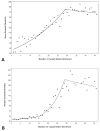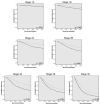Lymphadenectomy with Optimum of 29 Lymph Nodes Retrieved Associated with Improved Survival in Advanced Gastric Cancer: A 25,000-Patient International Database Study
- PMID: 28017807
- PMCID: PMC5606192
- DOI: 10.1016/j.jamcollsurg.2016.12.015
Lymphadenectomy with Optimum of 29 Lymph Nodes Retrieved Associated with Improved Survival in Advanced Gastric Cancer: A 25,000-Patient International Database Study
Abstract
Background: Gastric adenocarcinoma is an aggressive disease with frequent lymph node (LN) metastases for which lymphadenectomy results in a survival benefit. In the US, the National Comprehensive Cancer Network guidelines recommend D2 lymphadenectomy or a minimum of 15 LNs retrieved. However, retrieval of only 15 LNs is considered by most international guidelines as inadequate. We sought to evaluate the survival benefits associated with a more complete lymphadenectomy.
Study design: An international database was constructed by combining gastric cancer cases from the Surveillance, Epidemiology, and End Results program database (n = 13,932) and the Yonsei University Gastric Cancer database (n = 11,358) (total n = 25,289). Kaplan-Meier survival analysis was performed along with Joinpoint analysis to obtain the optimal number of LNs to retrieve based on survival. Prognostic significance of number of nodes retrieved was then confirmed with univariate and multivariate analyses.
Results: Analysis for both mean and median survival yielded 29 LNs removed as the Joinpoint. This was confirmed with multivariate analysis, where 15 retrieved LNs cutoff fell out of the model and 29 retrieved LNs remained intact, with a hazard ratio of 0.799 (95% CI 0.759 to 0.842; p < 0.001). Stage-stratified Kaplan-Meier analysis for a cutoff point of 29 LNs also demonstrated a statistically significant improvement in survival.
Conclusions: Joinpoint analysis has allowed for the creation of a model demonstrating the point at which additional dissection would not provide additional benefit. This large international dataset analysis demonstrates that the maximal survival advantage is seen by performing a lymphadenectomy with a minimum of 29 LNs retrieved.
Copyright © 2016 American College of Surgeons. Published by Elsevier Inc. All rights reserved.
Figures




Comment in
-
Discussion.J Am Coll Surg. 2017 Apr;224(4):555-556. doi: 10.1016/j.jamcollsurg.2017.01.026. J Am Coll Surg. 2017. PMID: 28343498 No abstract available.
Similar articles
-
Survival Analysis with Extended Lymphadenectomy for Gastric Cancer: Removing Stage Migration from the Equation.Am Surg. 2017 Oct 1;83(10):1074-1079. Am Surg. 2017. PMID: 29391098
-
Number of Lymph Nodes Removed and Survival after Gastric Cancer Resection: An Analysis from the US Gastric Cancer Collaborative.J Am Coll Surg. 2015 Aug;221(2):291-9. doi: 10.1016/j.jamcollsurg.2015.04.024. Epub 2015 May 5. J Am Coll Surg. 2015. PMID: 26206635 Free PMC article.
-
Impact of total lymph node count on staging and survival after gastrectomy for gastric cancer: data from a large US-population database.J Clin Oncol. 2005 Oct 1;23(28):7114-24. doi: 10.1200/JCO.2005.14.621. J Clin Oncol. 2005. PMID: 16192595
-
Prognosis for gastric carcinomas with an insufficient number of examined negative lymph nodes.Eur J Surg Oncol. 2014 Mar;40(3):358-65. doi: 10.1016/j.ejso.2013.08.027. Epub 2013 Sep 8. Eur J Surg Oncol. 2014. PMID: 24075824
-
Is it necessary to dissect the posterior lymph nodes along the splenic vessels during total gastrectomy with D2 lymphadenectomy for advanced gastric cancer?Eur J Surg Oncol. 2017 Dec;43(12):2357-2365. doi: 10.1016/j.ejso.2017.09.008. Epub 2017 Sep 19. Eur J Surg Oncol. 2017. PMID: 29032923
Cited by
-
Determinant Factors on Differences in Survival for Gastric Cancer Between the United States and Japan Using Nationwide Databases.J Epidemiol. 2021 Apr 5;31(4):241-248. doi: 10.2188/jea.JE20190351. Epub 2020 Apr 11. J Epidemiol. 2021. PMID: 32281553 Free PMC article.
-
Lymph node retrieval in radical gastrectomy: the pathologist alone or the surgeon-pathologist team?Prz Gastroenterol. 2021;16(3):224-228. doi: 10.5114/pg.2021.108987. Epub 2021 Sep 17. Prz Gastroenterol. 2021. PMID: 34584584 Free PMC article.
-
[Gastric cancer].Wien Med Wochenschr. 2023 Jun;173(9-10):227-231. doi: 10.1007/s10354-023-01011-x. Epub 2023 Apr 18. Wien Med Wochenschr. 2023. PMID: 37071301 German.
-
Effect of visceral obesity on outcomes of fluorescence-guided lymphadenectomy during laparoscopic gastrectomy for gastric cancer: Post hoc analysis of a randomized phase 3 trial.Chin J Cancer Res. 2024 Oct 30;36(5):503-516. doi: 10.21147/j.issn.1000-9604.2024.05.04. Chin J Cancer Res. 2024. PMID: 39539814 Free PMC article.
-
D2 Lymphadenectomy for Gastric Cancer: Advancements and Technical Considerations.Ann Surg Oncol. 2025 Mar;32(3):2129-2140. doi: 10.1245/s10434-024-16545-6. Epub 2024 Nov 26. Ann Surg Oncol. 2025. PMID: 39589578 Review.
References
-
- Cunningham D, Allum WH, Stenning SP, et al. Perioperative chemotherapy versus surgery alone for resectable gastroesophageal cancer. N Engl J Med. 2006 Jul 6;355(1):11–20. - PubMed
-
- Macdonald JS, Smalley SR, Benedetti J, et al. Chemoradiotherapy after surgery compared with surgery alone for adenocarcinoma of the stomach or gastroesophageal junction. N Engl J Med. 2001 Sep 6;345(10):725–30. - PubMed
-
- Bang YJ, Kim YW, Yang HK, et al. Adjuvant capecitabine and oxaliplatin for gastric cancer after D2 gastrectomy (CLASSIC): a phase 3 open-label, randomised controlled trial. Lancet. 2012 Jan 28;379(9813):315–21. - PubMed
-
- Sakuramoto S, Sasako M, Yamaguchi T, et al. Adjuvant chemotherapy for gastric cancer with S-1, an oral fluoropyrimidine. N Engl J Med. 2007 Nov 1;357(18):1810–20. - PubMed
MeSH terms
Grants and funding
LinkOut - more resources
Full Text Sources
Other Literature Sources
Medical

